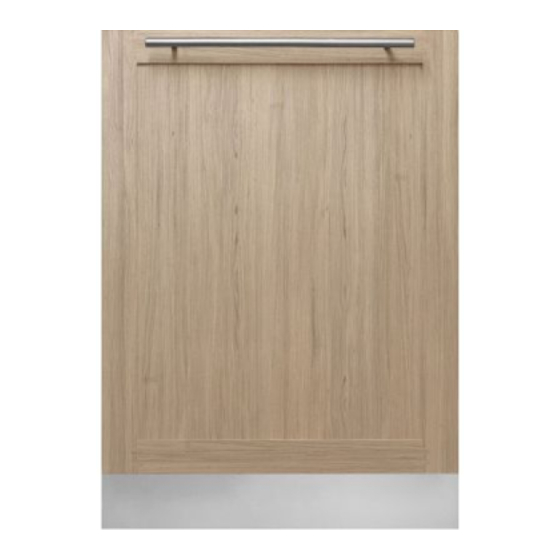Asko D5526XLFI Operating Instructions Manual - Page 7
Browse online or download pdf Operating Instructions Manual for Dishwasher Asko D5526XLFI. Asko D5526XLFI 20 pages.
Also for Asko D5526XLFI: Design Manual (20 pages), Design Manual (20 pages)

Using the dishwasher
Add detergent
1 Prewash detergent compartment
2 Main wash detergent compartment
We recommend that you use only unscented, granular automatic
dishwashing detergent. Using the wrong detergent could cause
flooding and/or damage your dishwasher. Do not use detergent
that has been wet and is clumped. Also, check the expiration
date on the container.
The amount of detergent needed can vary due to differences in
water hardness. To determine the water hardness in your area,
contact your local water utility or area water softening company.
The harder the water, the more detergent you may need. Refer
to the chart below for the recommended detergent amounts
based on water hardness. Remember, you should adjust the
amount of detergent you use by small amounts until you find the
correct amount. Twelve grains and higher is extremely hard water
and detergent alone may not be enough. You may need to use
a water softener to maximize the performance of your dishwasher.
Also, in areas with hard water (9+) you may need to wash at
lower temperatures to prevent hard water deposits from forming
in tank and wash system. In hard water areas, both the dishes
and the machine can develop a white or gray film after a while.
If this happens, run the Normal wash program with high temper-
ature and two tablespoons of citric acid or commercially available
dishwasher cleaner in the detergent compartment (with no dishes
in the machine).
NOTE!
We recommend that you do not add prewash detergent for the
program Quick wash.
NOTE!
If you use a dishwashing detergent with a rinse aid additive,
you should not fill the rinse aid dispenser. This could cause a
film on your dishes.
Recommended detergent amounts based on water hardness
Water hardness
Detergent amounts
Soft
Prewash 1 teaspoon
(0-3 grains per gallon)
Main wash 1 to 1-1/2 tablespoons
Medium
Prewash 1 teaspoon
(4-8 grains per gallon)
Main wash 1 to 2 tablespoons
Hard
Prewash 1 teaspoon
(9+ grains*)
Main wash 2 to 3 tablespoons
*12 grains and higher is extremely hard water.
WARNING!
Children must be supervised – dishwasher detergent is corro-
sive!
NOTE!
Use only dishwasher detergent! Liquid hand-washing detergent
must not be used as the foam that forms prevents the dishwash-
er from operating effectively.
Dishwasher tablets
Halve the tablet if it is difficult to close the dispenser lid. There is
a risk that the detergent will not be released properly if the lid is
tight and cannot open correctly.
NOTE!
Dishwasher tablets are not recommended for short programs
(less than 75 minutes). Use powder or liquid dishwasher deter-
gent instead.
3-in-1/All-in-one detergent
Read through the directions for these products carefully. If any-
thing is unclear, contact the detergent manufacturer.
On/Left-on mode
Press and hold the On/Left-on mode button until the display lights
up.
Program selection
Press the Program selector one or more times until the desired
program symbol appears on the display.
Sanitation wash
A program with the ability to help with most household germs
and extra dirty dishware. This program will have a high final rinse
temperature for a good drying result and germ treatment.
NOTE! Do not put in dishware that cannot stand high wash or
rinse temperatures.
Normal wash
This program is recommended for daily, regular, or typical use
to completely wash a full load of normally soiled dishes, such as
plates, serving dishes, cups, and glasses. No options are recom-
mended.
Heavy wash
Program for very dirty dishes, such as pans, casserole dishes,
and oven dishes. If these dishes do not completely fill the dish-
washer, you can add plates and other dishes that can withstand
a Heavy wash to fill out the load.
Quick wash
This program is used for glasses and porcelain that is lightly
soiled, such as coffee cups.
7
